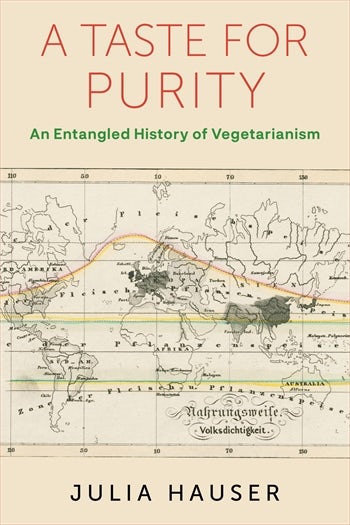Mixed flavors of vegetarianism

Published by: Columbia University Press

Surprising as it may seem, vegetarianism has not always been related to the ties between human and nonhuman animals. As a matter of fact, the history of vegetarianism is a testimony to the contrary especially as many of its origins as an organized movement are closely tied, sometimes even exclusively, to the relations between human animals. Julia Hauser’s latest book A Taste for Purity: An Entangled History of Vegetarianism is committed to revealing exactly how the vegetarian movements of nineteenth-century South Asia, Europe and North America were mainly concerned with very human affairs that spanned from colonialism to anticolonialism, from nationalism to internationalism, from racial issues to gender issues, with little or almost no concern for the nonhuman actors who, most often than not, were a mere pretext. Hauser takes as a departure point the fact that, during the second half of the nineteenth century, an era marked by the rapid expansion of European colonial rule, “meat became centrally important to diets worldwide as a signifier of masculinity, strength, good health, and wealth.”(p. 4) Although opposed to this meat supremacy, various vegetarian movements also laid the groundwork for what Hauser argues to be their common denominator: “a taste for purity” (p. 4), which mainly translated into racialized categories of humans, something that both the European colonizers (with their appetite for meat) and the colonized Asia (with its seemingly traditional vegetarianism) shared.
Arguing that people participating in encounters with others may not always communicate all their presumptions and purposes and that knowledge is usually situated albeit without having a single center, Hauser’s study focuses on how European, Indian, and American vegetarians apparently imagined each other according to their own aims and prejudices, thus giving rise to movements that were concerned with hierarchies even if they did not openly admit this: “In both India and the West, vegetarian bodies were imagined as morally and physically pure, whereas meat eaters were considered to be degenerate.” (p. 8) For instance, new European and North American religious movements in the 19th century deemed the physical body as the core of spiritual salvation meaning that a meat-eating body was not on the right path toward salvation and, ultimately, toward a purer race and nation: “Vegetarianism was thus bound up intimately not only with nationalism, but often with eugenics and racism as well.”(p. 8) Such imaginary constructs were intimately tied to thinking of the self-induced individual transformation as the first step toward the evolution of the entirety of humankind, even if this was a transformation that aggressively excluded those from the lower classes/caste, who were also perceived as possessing a lower morality brought about by the wrong kind of nutrition. Such fantasies were mainly brewed by a lack of real knowledge about particular local geographies, but also because of the limited access to the real way most people lived in these geographies.
new European and North American religious movements in the 19th century deemed the physical body as the core of spiritual salvation meaning that a meat-eating body was not on the right path toward salvation
The consumption of meat in Europe and North America was also linked to the image of an enhanced masculinity while vegetarian males were perceived as lacking in masculinity, especially if they were hailing from the colonized corners of the world. Emerging as a counterreaction to this imagined masculinity and, ultimately, superiority, anticolonial discourses also built their rhetoric upon a nationalism that excluded non-vegetarian communities while stressing the importance of a vegetarian diet as a powerful tool to overthrow the colonial powers. Against this background, vegetarianism soon became entangled with the calls for “a New Man” — a hardworking, controlled, even ascetic individual (read: male) who could easily transform into a political leader by applying himself to a wide range of ideologies and their consequent struggles: the masculinity vegetarianism promoted “always centered physical and mental strength and the ability to keep in check one’s desires and emotions.” (p. 114) The ideal of a hard and combative masculinity was also a by-product of a certain kind of hybrid knowledge that combined everything it could use for its own benefit but, more importantly, which could be accommodated to various political agendas. So much so, that one might have trouble imagining them together. As this hybrid knowledge was keen on showing “how vegetarianism facilitated killing by providing soldiers with greater energy than a meat-based diet could” (p. 118), it was only a matter of time until the cult of the so-called New Man/Male culminated in the perfect marriage of violence and vegetarianism.
But vegetarian movements and their official discourses did not circumvent the notions of race and nation either. As a matter of fact, entire categories of meat-eating people were written out of the national histories of countries such as India, which cast itself as the new promoter of peace especially during the post-war period but also as a national entity that was not affected by the divisions generated by the Cold War: “The rejection of meat, fish, and potentially other animal products was now imagined as a force of peace.” (p. 147) However, another aspect that was written out is the way most lower-class and casteless people in India who were also meat-eaters were pushed aside in the constant endeavour to depict vegetarianism and nonviolence as a sort of national heritage despite the mounting evidence to the contrary, including the fact that India had always had a rather diverse alimentary heritage of which vegetarianism was merely a part. This way, the main stage was reserved for the upper-caste Hindus, who were seen as the perfect vectors for the creation of the new Indian state, one free of colonialism that saw vegetarianism as a means of improvement for its citizens, both at a political and a personal level. So, in spite of all the advertised internationalism, pacifism and the accompanying vegetarian dishes, the official discourses were undergirded by racist and ultimately violent tendencies toward those who did not comply with their demands for a stronger, purer race and nation.
Hauser concludes that this insight and the rather contradictory stories it tells is one that needs to be challenged and eventually corrected by contemporary researchers
Highlighting how the situated knowledge produced by vegetarian movements built upon ideologies that were not necessarily progressive and which contrasted a seemingly modern European and North American vegetarianism with a seemingly more traditional vegetarianism in South Asia, Hauser concludes that this insight and the rather contradictory stories it tells is one that needs to be challenged and eventually corrected by contemporary researchers: “This book could only look at those who were vociferous—not those who were silent, who listened, and perhaps interpreted what they read or listened to differently.” (p. 171)
M. Buna is a freelance writer.
